Dee Estuary Birding
Monthly Newsletter...
November 2021 Newsletter
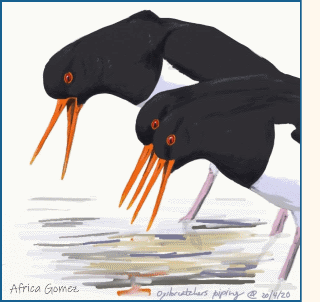
Wader Conservation World Watch 2021
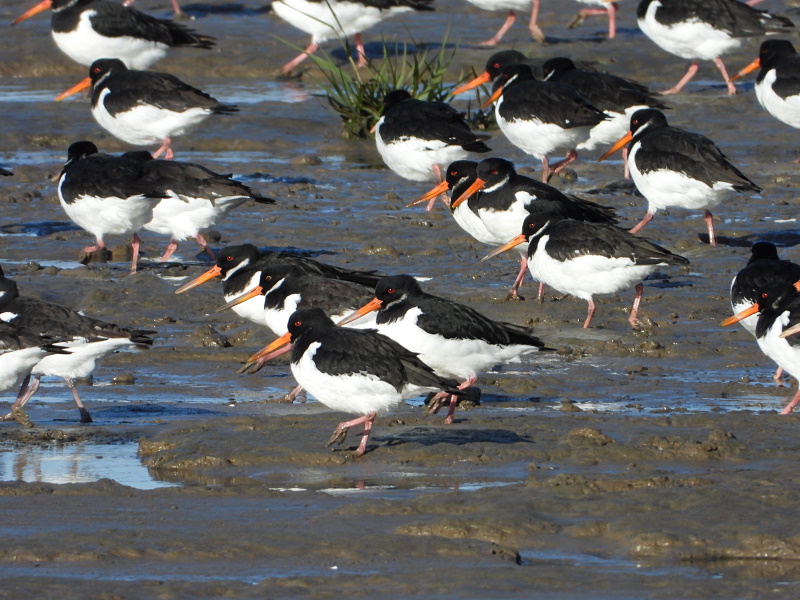
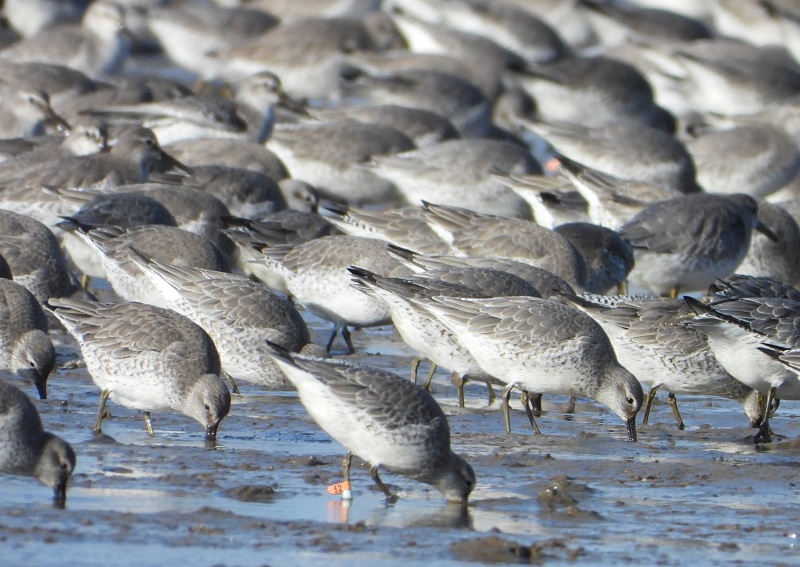
Bottom: Knots feeding on West Kirby Shore at low tide (February 2021) © Richard Smith
The purpose of WCWW is not just to highlight waders and the problems they are facing, but also to celebrate the people who are involved, either professionally or voluntarily, in their conservation. Whether a person’s involvement is as a researcher, ringer, conservationist, warden, birdwatcher or fundraiser, this event is a fun way to say ‘thank you’ to them and for the participants to say ‘I Care’ about what is happening to the world’s waders.
The Dee Estuary and north Wirral coast will be full
of waders on 6th and 7th of November. There are some high spring tides
on those two days and if you want to see waders I would get to the high
tide roosts at least an hour before high tide with Hoylake and Point of
Ayr particularly recommended. If you want to see birds feeding at low
tide then the stretch of coast between the south end of West Kirby
Marine Lake and Heswall Marsh should be good although a telescope is
essential if you want to scan through the massed flocks way out on
Dawpool Bank.
Nov 6th 11.39hrs 9.9m
Nov 7th 12.23hrs 9.8m

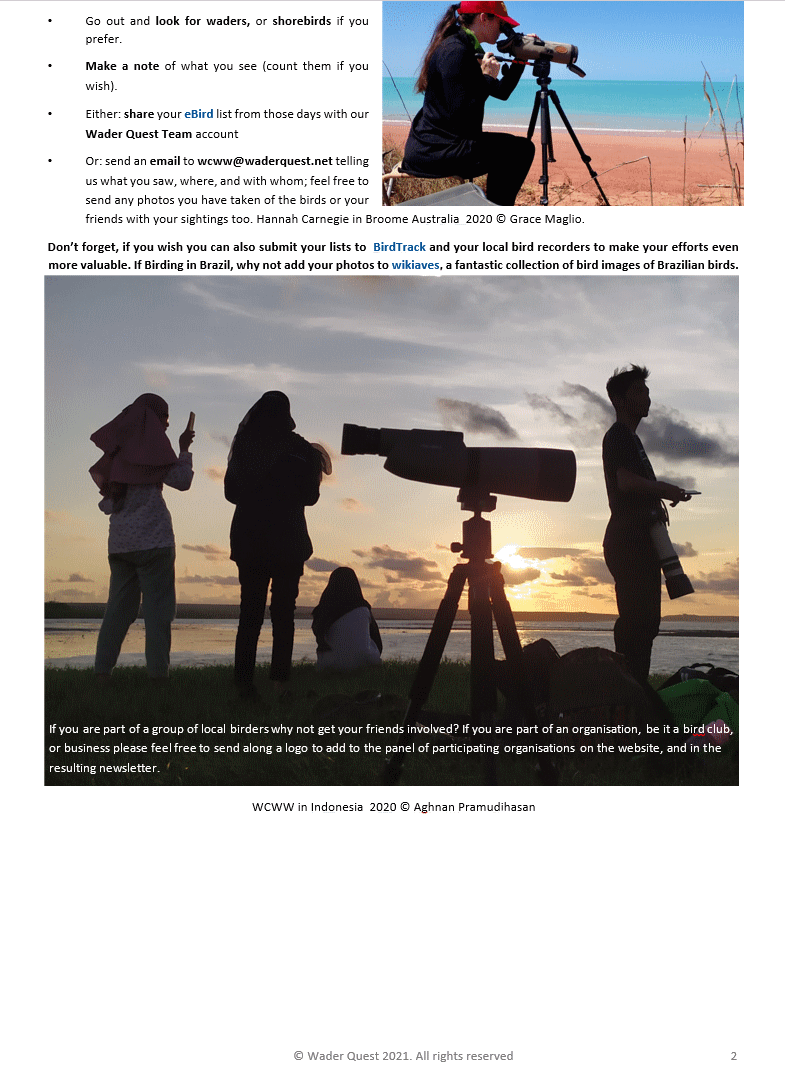
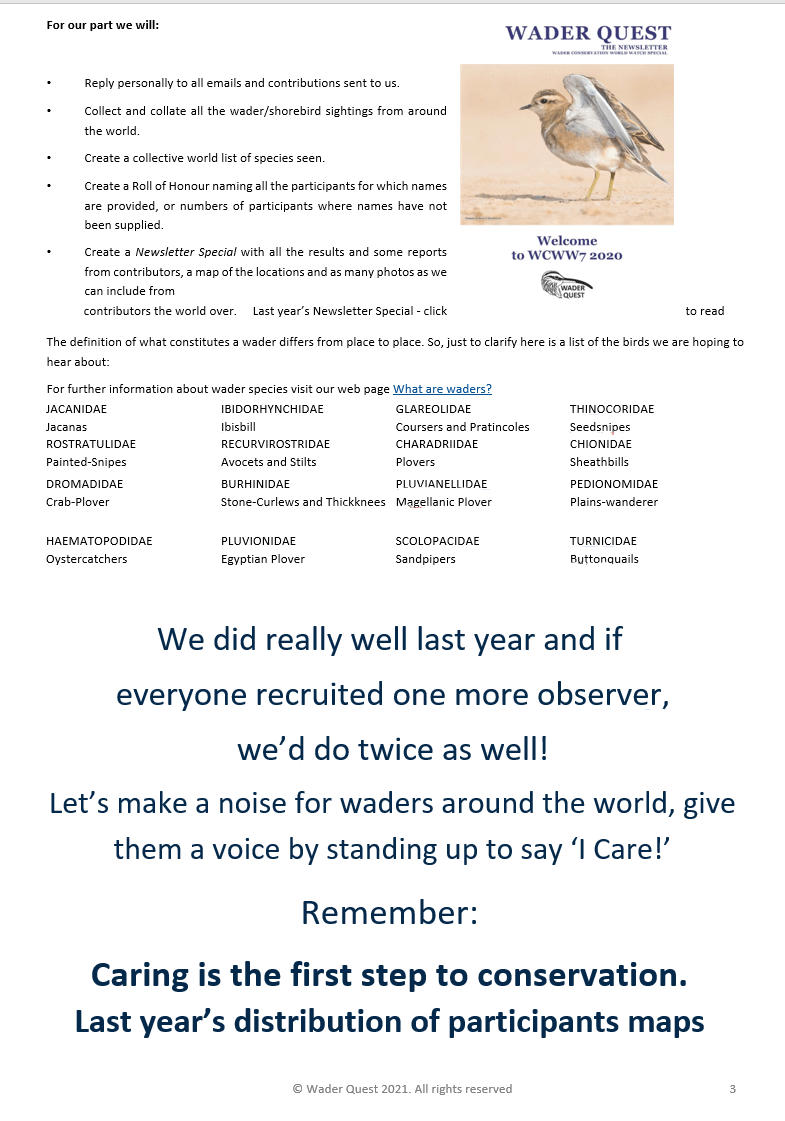
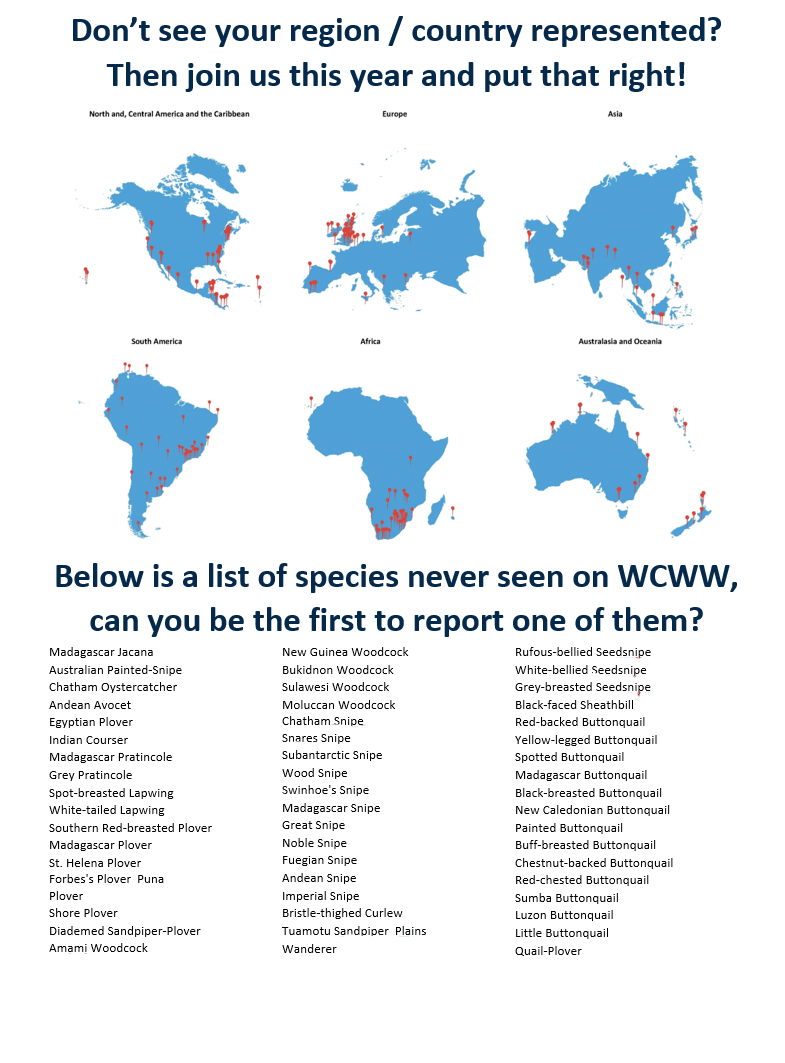
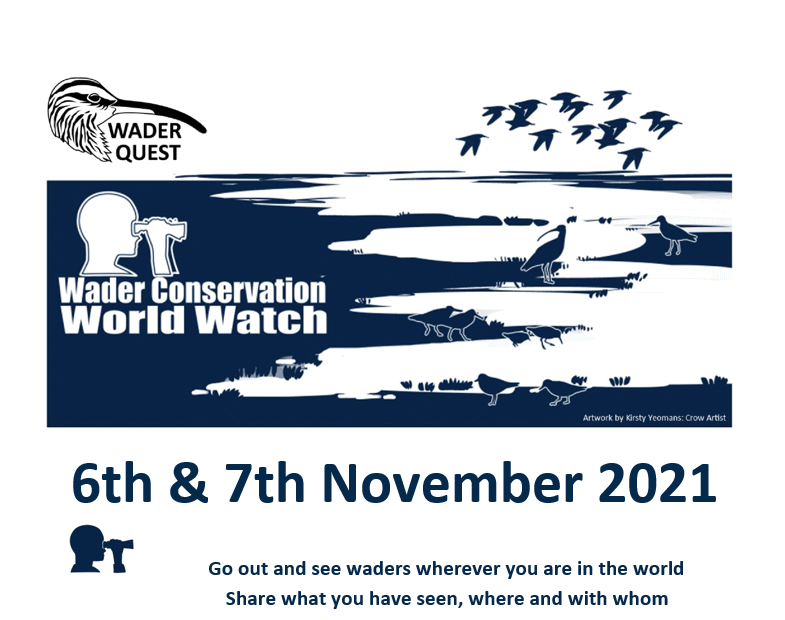
| by either Sharing your eBird checklist with the Wader Quest Team account or Sending an email to wcww@waderquest.net I CARE! REMEMBER CARING IS THE FIRST STEP TOWARDS CONSERVATION WADER QUEST - THE NATURAL HOME FOR WADER LOVERS www.waderquest.net |
For further information take a look
at the Wader Conservation World Watch website:
https://www.waderquest.net/events/wader-conservation-world-watch/
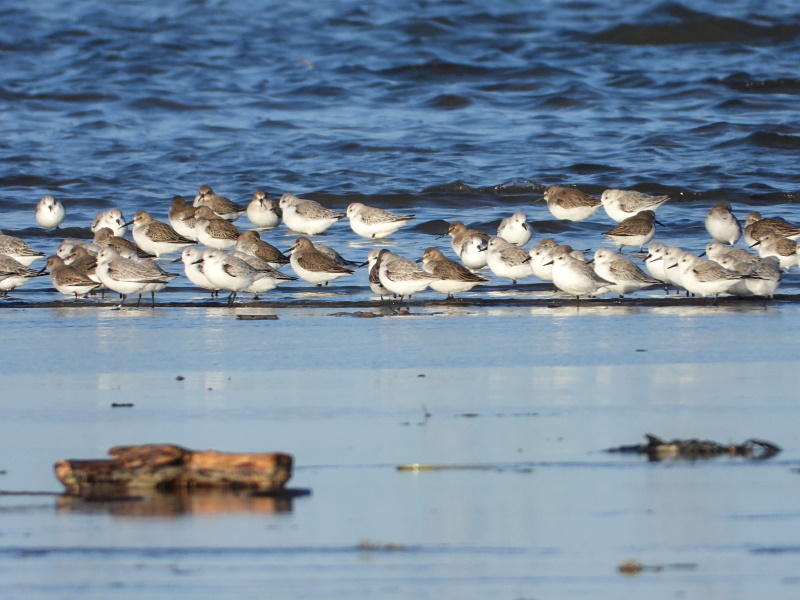
Colour Ring Report
Oystercatchers
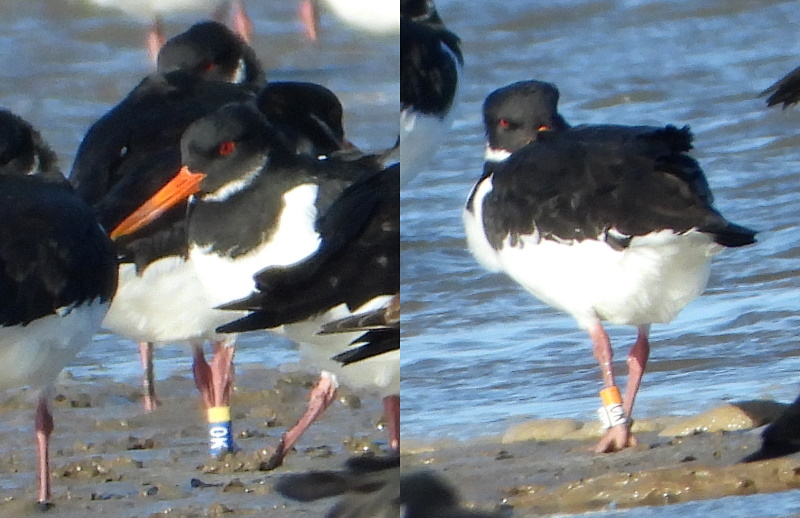
Yellow over Blue
(OK).
Ringed on the Exe Estuary at Dawlish Warren on 04/02/2018 and recorded
there in March 2018, September 2018 and February 2021.
Recorded at Tichfield Haven NNR, Hampshire, on 12/05/2021 and at
Hoylake shore on 21/10/2021.
Orange over White
(CK).
Ringed as a chick on 13/06/2017 at Glen Cova, Angus.
Recorded at Seaforth on 28/07/2018 and at
Hoylake on 20/09/2017 and 21/10/2021.
Knots
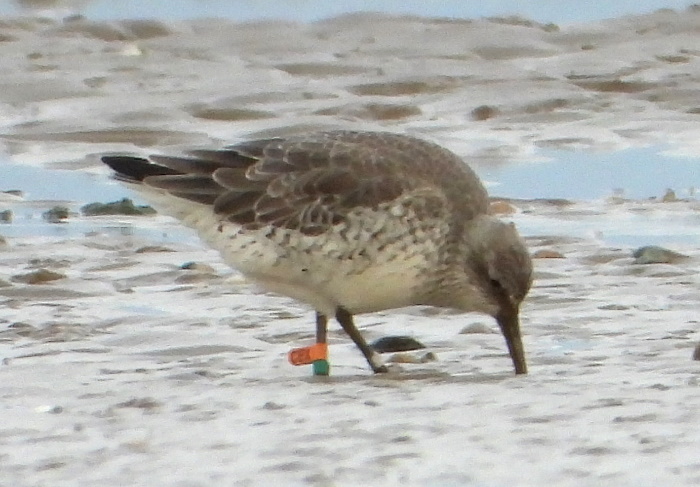
The first of our over-wintering Knots arrived during
October and we managed to read a handful of the 'O flags' including
this one:
Orange Flag (CEX)
over Green ring.
Caught at Beaumaris (Anglesey) on 17/01/2010 and fitted with a metal
ring.
Colour-ringed near the Alt Estuary on 30/03/2018.
Recorded on the Dee Estuary at Thurstaston November 2018, 2019 and 2020
and also at Meols December 2020.
In March 2019 it must have been on it's way north when it was spotted
in Findhorn Bay, north-east Scotland.
It is a regular on the Sefton coast with the earliest arrival being
late July and latest record before breeding being mid-April.
It moved back to Wales earlier this year when it was recorded at Bangor
on 18/01/2021.
Recorded at Ainsdale on 27/07/2021 and Thurstaston on 19/10/2021.
Grey Plovers
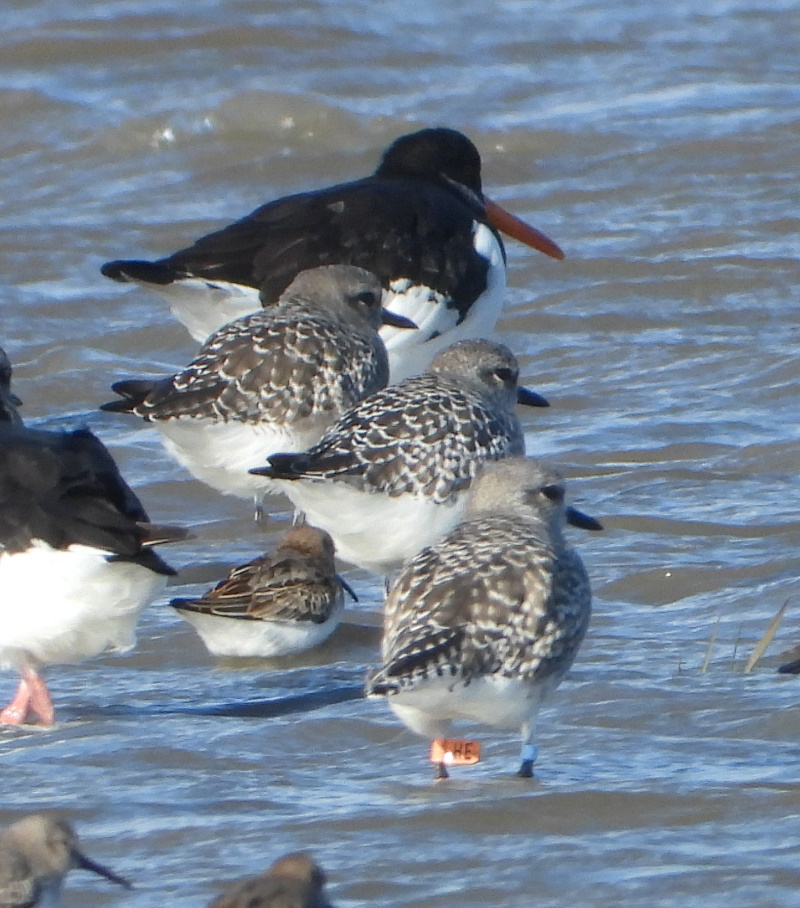
Four colour-ringed Grey Plover were recorded in October. Two at
Hoylake, one at West Kirby and one at Thurstaston. Three were ringed
locally and these have Orange flags, here are the records for Oflag
(HE):
Oflag (HE).
Since being ringed near the Alt Estuary on 30/3/2018 it has been
recorded at Hoylake four times and along the Sefton coast between
Formby beach and Southport 20 times.
Last recorded at Holylake on 24/10/2021.
The following is the first colour ringed Grey Plover we've recorded on
the Dee Estuary which was not ringed at the Alt Estuary:
Left leg: Yellow
flag over Yellow ring over Red ring, Right leg: Green ring over yellow
ring.
Ringed on the island of Griend (Dutch Waddensea) on 08/09/2021.
Recorded at Thurstaston on 10/10/2021.
It turned out to be the first Dutch colour-ringed Grey Plover ever to
be seen in the UK:
"It’s the first Grey Plover which we have colour ringed in the Dutch
Wadden Sea which is reported in the UK. Ringed on the island of Griend
on 8 September 2021 as an 2CY bird. We recently started a project on
Grey Plovers because we have many questions about their annual rhythms
and migration patterns. We started colour ringing on the Russian
tundra, and have ringed birds in the Wadden Sea and Mauritania too,
almost 70 individuals in total." (Job ten Horn).
Common Gulls
Late summer and early autumn 2021 brought with it an
unusually large
number of Common Gulls to the estuary and we managed to spot four
colour-ringed ones. Three had been ringed in Norway and the other in
north-east Scotland. We've only managed to obtain detailed records of
two of these, as follows.
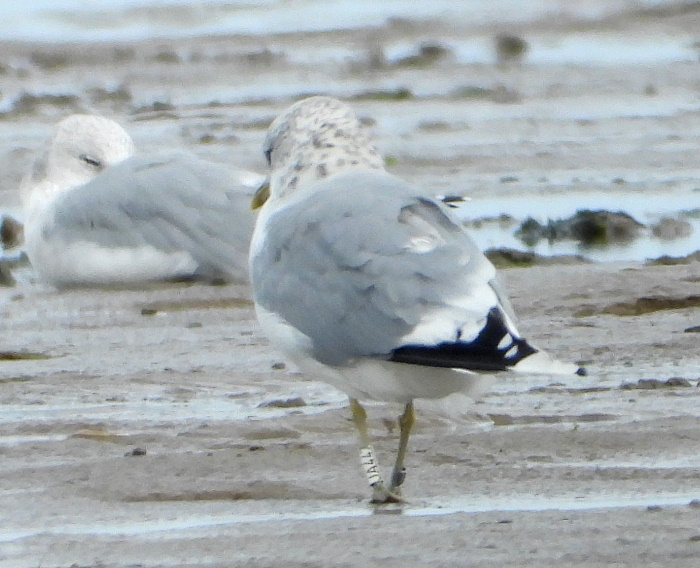
JA447 on a white ring.
Ringed as a breeding adult near Bergen, Norway, on 05/06/2016 where it
was also recorded on 11/07/2021.
Recorded on Hoylake shore in August 2016, October 2017, August 2018 and
on 11/09/2021 and 21/09/2021.
JH358 on a white
ring.
Ringed as a chick near Stavanger, Norway, on 30/06/2019.
Recorded at Finisterre, France, in the winter of 2019/20 and on Hoylake
Shore on 05/09/2021.
Lesser Black-backed Gull
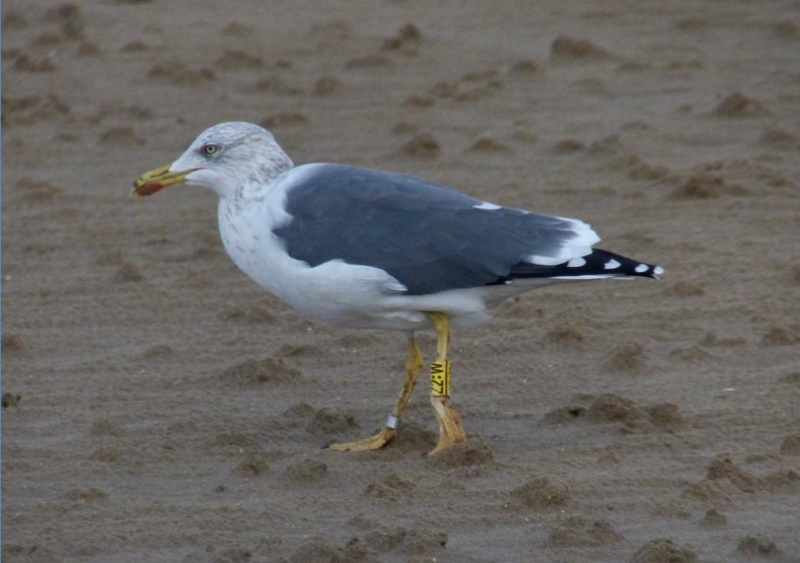
Z2:W on a yellow
ring.
Ringed on Banks Marsh, Ribble Estuary, on 24/05/2017.
Recorded at Hilbre (between Middle Eye and Little Eye) on 09/10/2018
and
01/10/2021.
Colour Rings were recorded by Richard Smith, Steve Hinde, Ros Green, Tim Kinch and Steve Williams.
October Bird News
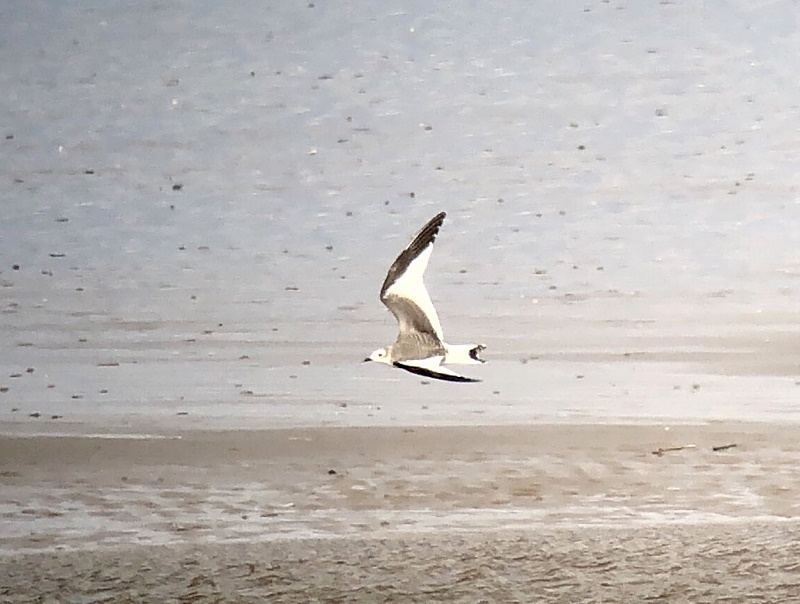
Gales early in the month brought in some good sea
birds after a
disappointing September. 12 Leach's Petrels, 6 Arctic Skuas, 6 Great
Skuas and 1 Sabine's Gull were the totals. In addition a Little Auk
flew past Hilbre on the 21st and a Grey Phalarope was spotted exiting
the River Mersey on the 22nd.
Visible migration was notable for the passage of hundreds of Redwings
through the area on several days through the month, but in contrast a
near total
lack of
Fieldfares. This appears to have been the case right across the country
as illustrated by the migration monitoring website https://trektellen.org/
,
see the two bar charts below with October weekly totals for Redwing and
Fieldfares migrating into the UK for 2021, 2020 and 2019. October 2021
saw numbers of Fieldfares less than 2% of the previous two years.
Presumably they are arriving late this year!
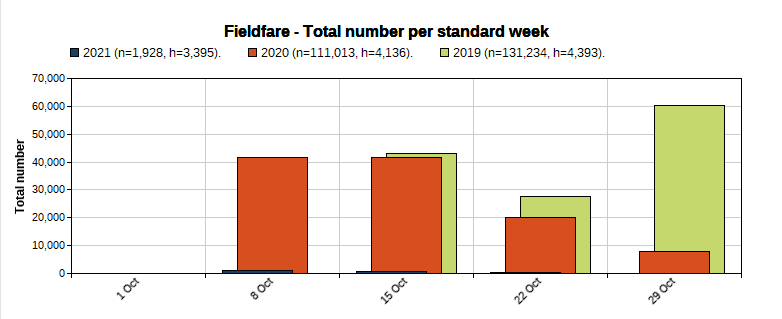
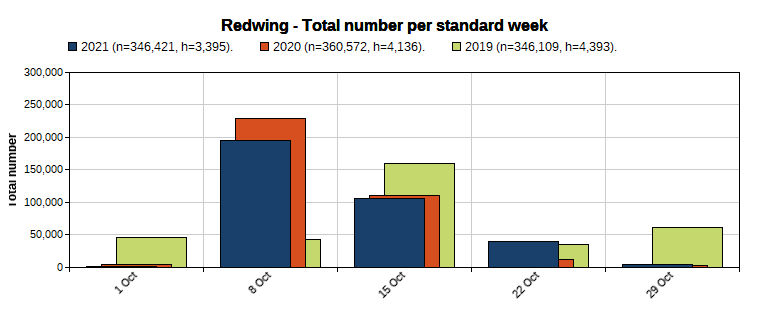
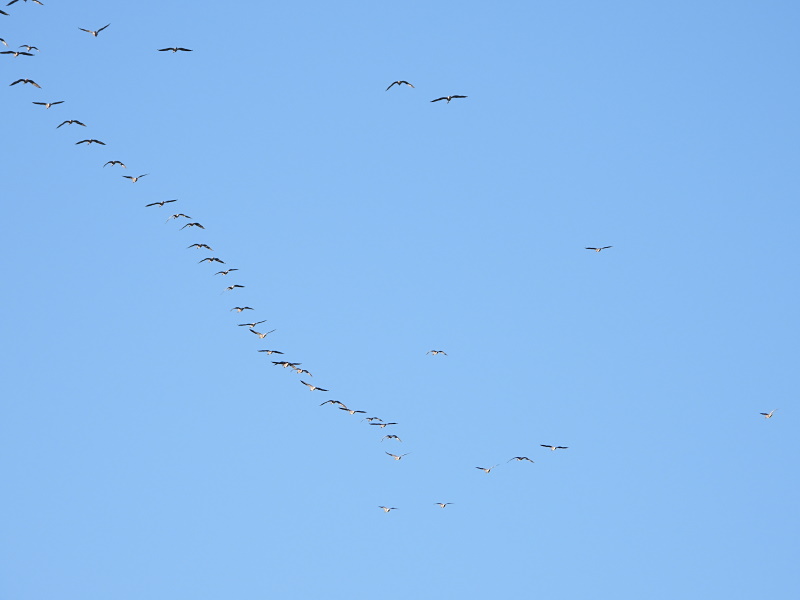
The 6,300 Shelducks spread over Dawpool Bank off
Thurstaston on the 7th was probably the biggest flock in the country
for October, and 4,320 Redshanks at nearby Heswall on the 1st was also
a
pretty impressive number. The dramatic increase in Pink-footed Geese
numbers in recent years has been well documented on this website and
12,500 flying into roost on the 25th was a fantastic sight.
On the marshes 13 Marsh Harriers were seen over
Neston Reedbed on the 19th with total numbers probably well over that.
A grey male and at least one ringtail Hen Harrier were present through
the month. Cattle Egrets reached a total of eight, the max count of
Great Egrets was 38 and up to three Spoonbills were present.
Two records of Snow Buntings this month, singles at
Hilbre and Meols. A Firecrest was a nice find On Hilbre on the 8th, a
Lesser Spotted Woodpecker was in a West Kirby garden on the 19th and
just one report of a Yellow-browed Warbler with one at Burton on the
28th. A Long-tailed duck was at Burton Mere Wetlands on the 30th.
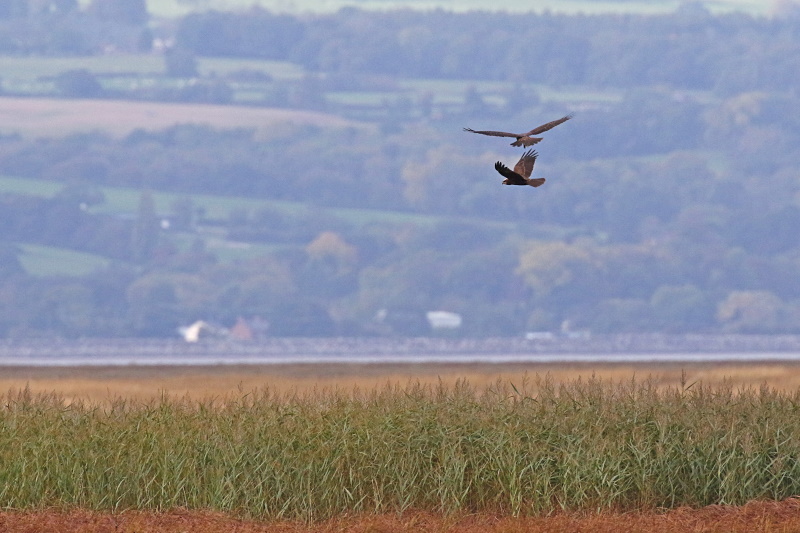
What to expect in November
We already had an influx of Cattle and Great Egrets in October but
expect even more in November, last year we had at least 15 Cattle and
over 30 Great. Both Harrier species should be present in good numbers
with at least four Hen Harriers (hopefully including one or two grey
males) and Marsh Harriers well into double figures. Also on the marshes
one or two Bitterns should be lurking, usually only seen when they fly
into Neston Reedbed to roost.
Our overwintering waders will have arrived, last
year we had a count of 40,000 Knots, mostly off Caldy and Thurstaston,
during a low tide count mid-November. Also expect plenty of Dunlins,
Grey Plovers
and Sanderlings.
The high spring tides during the first weekend of
the month should produce some spectacular numbers off wildfowl flushed
from the marshes including Pink-footed Geese, Wigeon, Pintail and Teal
and many of these may relocate to Burton Mere Wetlands. Also in
November we start to see ducks frequenting West Kirby Marine Lake with
Goosanders now the most regular species. Shotwick Lake is well worth a
look for ducks including a Long-tailed duck which turned up last year,
as well as a Slavonian Grebe. The new proto-sand dunes at Hoylake
attracted a small flock of Snow Buntings last winter so it would be
nice if they returned, but this lovely finch can turn up anywhere along
north Wirral including Hilbre and West Kirby, as well as between Point
of Ayr and Gronant.
On a calm day it's well worth looking out to sea at
high tide where there could well be thousands of Common Scoters and
hundreds of Great Crested Grebe - but they will be a long way out!
Top of Page
Forthcoming Events
November Highest Spring Tides (Liverpool)
Also see Tides page.
5th November, 10.58hrs (GMT), 9.8m.
6th November, 11.39hrs (GMT), 9.9m.
7th November, 12.23hrs (GMT), 9.8m.
Forthcoming Events
At last, the return of events!!
Friday 5th November - High Tide Wader Watch at Point of Ayr RSPB09.00hrs to 12.00 hrs.
By November, most of our winter visitors will be back on the mudflats and saltmarsh that make the Dee Estuary such an important home for wetland birds, and witnessing a high tide at Point of Ayr is a spectacle not to be missed.
Thousands of godwits, redshanks, oystercatchers and curlews gather in spectacular fashion on the saltmarsh and shingle here at high tide, along with a variety of ducks - pintail, shelduck, teal and mallard - pushed close on the incoming tide, and there's always the chance that something unexpected will show its face! Peregrine and merlin are the two raptors most likely to take advantage of this high tide buffet, so there's a chance of seeing these hunting at close range.
This exclusive guided walk with the reserve's former warden has strictly limited numbers and will give you an intimate insight into the key wildlife and importance of the Point of Ayr part of the RSPB Dee Estuary reserve. The event starts with a gentle stroll through the sand dunes to the beach looking for highlights on the rising tide, then along the sea wall to our hide to watch the tide peak, covering around 2 miles in total, on some soft ground.
Appropriate outdoor clothing and footwear suitable for the weather conditions are essential, with binoculars and/or telescope highly recommended! Feel free to pack some snacks for in the hide, and a hot flask is recommended at this time of year!
Park in one of the public car parks signposted from Station Road and meet outside 'The Point' bar at the end of Station Road ready for a 9am start. Car parks are Pay & Display so don't forget some coins. Public toilets and places to purchase refreshments will be available in Talacre before and afterwards.
Booking essential - go to https://events.rspb.org.uk/events/8633 and click on the orange 'Buy now' button on the bottom of the page.
Wedenesday 17th November - Wildfowl Watch at Burton Mere Wetlands RSPB
14.30hrs to 17.00hrs.
The UK's wetlands are a vital winter home for thousands of wading birds and wildfowl, and the Dee Estuary is one of the best places in the country to see them.
Join us for this exclusive afternoon walk with the reserve's former warden to brush up on your ID and marvel at the flocks of ducks, geese and and a variety of other water birds that spend the winter here. Eight types of ducks and up to five types of geese can be seen here at this time of year, in colourful breeding plumage after their autumn moult.
This gentle walk will cover around 2 miles along fully accessible trails to Burton Mere Wetlands' new Border hide, stopping at screens and viewpoints along the way. As dusk approaches, finish back at the visitor centre for a drink and a snack of your choice, staying for half an hour after the reserve closes to visitors to experience - weather permitting - one of our dramatic sunsets, and the flurry of activity of birds flying to roost on the reserve.
Appropriate outdoor clothing and footwear suitable for the weather conditions are essential, with binoculars and/or telescope highly recommended, but binoculars can be hired here on the day! Please note, we request for face coverings to be worn indoors unless exempt, except to eat and drink.
Ticket price includes the drink and snack, plus the reserve entry fee for non-members. Members should bring their membership card to present on arrival.
Booking essential - go to https://events.rspb.org.uk/events/8635 and click on the orange 'Buy now' button on the bottom of the page.